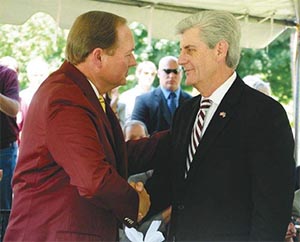News at the HPC²
Officials Laud MSU's Leadership of National UAS Center
June 8, 2015 State leaders joined Mississippi State senior leadership and researchers to discuss the university's lead role for the Federal Aviation Administration's new National Center of Excellence (COE) for Unmanned Aircraft Systems.
State leaders joined Mississippi State senior leadership and researchers to discuss the university's lead role for the Federal Aviation Administration's new National Center of Excellence (COE) for Unmanned Aircraft Systems.The six-year competitive effort to land the project was realized in May when the FAA announced the Mississippi State-led Alliance for System Safety of UAS through Research Excellence (ASSURE) will operate the new national center. (Learn more about ASSURE at www.assureuas.org)
While research will take place at member universities throughout the U.S. and globally, the center's work will be concentrated at Stennis Space Center in Hancock County to take advantage of airspace over the Gulf of Mexico, in the Mississippi Delta to conduct unmanned precision agriculture research, and around MSU's Raspet Flight Research Lab in Starkville.
The directive to the FAA to establish the national center has been included in congressional appropriations bills since FY2012, with Congress appropriating $5 million to support a five-year agreement with the COE UAS. Federal funding will be matched by ASSURE team members.
The FAA expects the COE to begin research in 2015 and be fully operational in 2016 in its exploration of evolving new technological developments regarding unmanned aircraft and their uses, including detect-and-avoid technology, low-altitude operations safety, privacy safeguards and other areas. Research also will involve the deployment of UAS for emergency response, biofuel and clean fuel technologies, law enforcement activities, and agricultural and environmental monitoring.
Moreover, the COE UAS will coordinate research and development activities with the National Aeronautics and Space Administration, the Department of Defense, the Department of Homeland Security, Department of Agriculture and other agencies. Its work will also lead to recommendations on aircraft certification, flight standards and air traffic requirements, and facilitate UAS technology transfer to other civilian and defense agencies.
To view the full article, please see: Mississippi State University News
Also see the article from The Dispatch
